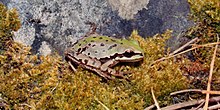
The Pine Barrens tree frog is a species of New World tree frog. It is becoming rare due to habitat loss.

The canyon tree frog is a species of tree frog native to the rocky plateau areas of southern United States, primarily in New Mexico and Arizona, but it also ranges to Utah, Texas, and Colorado, and as far south as the Mexican states of Michoacán, México, Guanajuato, Guerrero, and Oaxaca.
Nymphargus mariae, commonly known as Maria's giant glass frog, is a species of frog in the family Centrolenidae. It is found in the cloud forests of the Serranía de Sira, Huánuco, Peru and in Ecuador. A population endemic to Ecuador was previously considered to be a distinct species, Nymphargus puyoensis, but is now classified as a junior synonym.
The porthole tree frog is a species of frog in the family Hylidae endemic to Mexico. Its natural habitats are subtropical or tropical moist montane forests and rivers. It is threatened by habitat loss.
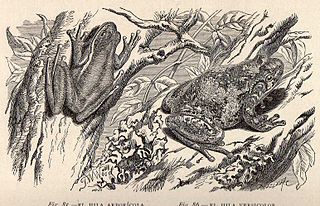
Dryophytes arboricola, commonly known as the arboreal treefrog, is a species of frog in the family Hylidae endemic to the Sierra Madre del Sur in Guerrero state, Mexico.
Bocourt's tree frog, or Bocourt's treefrog, is a species of frog in the family Hylidae endemic to Guatemala and found on the mountains of the southern Alta Verapaz Department and Baja Verapaz Department. It is named after Marie Firmin Bocourt, a French zoologist and artist.
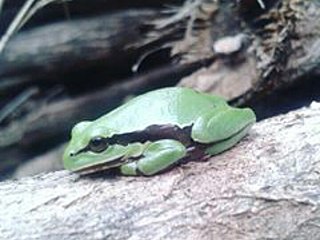
The southern highland tree frog is a species of frog in the family Hylidae endemic to Mexico. Its natural habitats are subtropical or tropical moist montane forests, subtropical or tropical high-altitude grassland, intermittent rivers, and intermittent freshwater marshes. It is threatened by habitat loss.
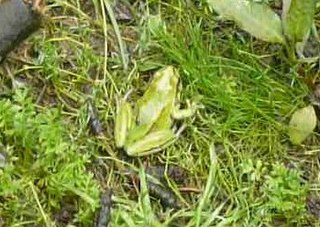
The ridged tree frog is a species of frog in the family Hylidae endemic to Mexico. Its natural habitats include mountainous pine-fir forests in high elevations. In lower elevations it is known to inhabit moderate and low-lying streams and ponds where it is believed to breed.
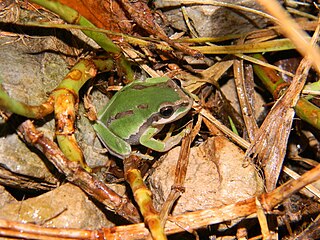
Walker's tree frog is a species of frog in the family Hylidae found in Guatemala and Mexico. Its natural habitats are highlands of pine-oak forests and pine-fir forests. It is known to occur in Chiapas Mexico and in parts of Guatemala including the Sierra de los Cuchumatanes mountain range in the west, the plateaus of central Guatemala, and in southeastern Guatemala. However, it is believed that its range is greater than what is currently known. It breeds in temporary ponds, and is threatened by habitat loss.

Wright's mountain tree frog is a species of frog in the family Hylidae found in Mexico and the United States. Its natural habitats are temperate forests, temperate grassland, rivers, and freshwater marshes. Dryophytes wrightorum has been regarded as a synonym of Dryophytes eximius, the mountain tree frog, which is listed as the state amphibian of Arizona. As presently circumscribed, Dryophytes eximius is endemic to Mexico and does not occur in Arizona. It is the state amphibian of Arizona.
The Arfak Mountain tree frog is a species of frog in the subfamily Pelodryadinae. It is endemic to West Papua, Indonesia. Its natural habitats are subtropical or tropical moist montane forests, rivers, rural gardens, and heavily degraded former forest. The threats are not known and is thought to be locally protected and occurs in Arfak Mountains National Park.
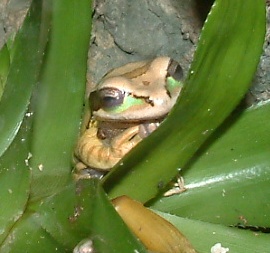
The blue-spotted Mexican tree frog is a species of frog in the family Hylidae found on the Atlantic slopes of southeastern Mexico, Belize, and Guatemala, between Jalapa de Díaz in Mexico and Sierra del Mico in Guatemala. Its natural habitats are humid mid-altitude and montane forests, and it can also occur in secondary forest. Breeding takes place in temporary pools and streams and in depressions in logs that fill up with water. It is threatened by habitat loss and, potentially, chytridiomycosis.

Leptopelis broadleyi is a species of frog in the family Arthroleptidae of uncertain status. The Amphibian Species of the World, the IUCN SSC Amphibian Specialist Group, and the African Amphibians do not recognize it, but instead consider it synonym with Leptopelis argenteus. However, the AmphibiaWeb recognizes it as a valid species.
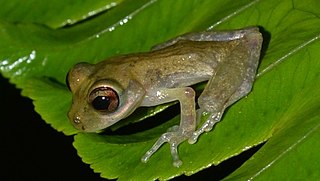
The Mount Tucuche tree frog is a species of tree frog in the family Hemiphractidae. It is found in Trinidad and Tobago and Paria Peninsula, Venezuela. It is an arboreal species occurring in various microhabitats of humid montane forest: leaf bases of bromeliads and aroids, bushes. It is threatened by habitat loss.
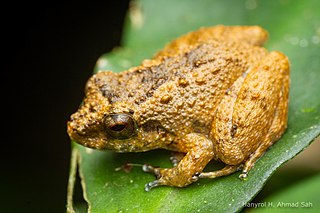
Alcalus baluensis is a species of frog in the family Ceratobatrachidae. It is endemic to northern and western Borneo. Its common name is Balu eastern frog or dwarf mountain frog. It was placed in the family Dicroglossidae before being transferred to Ceratobatrachidae in 2015.
Platymantis bimaculatus is a species of frog in the family Ceratobatrachidae. It is endemic to West Papua, Indonesia.

Dryophytes suweonensis, the Suweon treefrog or Suwon treefrog, is a species of frog in the family Hylidae endemic to the Korean Peninsula probably from the Imjin River to the Mangyeong River, south of Iksan. Its distribution and population have been assessed to be below 800 individuals and the status of the species has been updated as Endangered by the IUCN. The natural habitat of the species has been generally transformed into rice fields and it is threatened by habitat loss.

